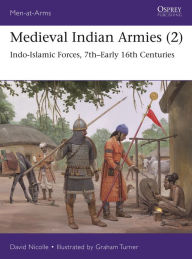Medieval Indian Armies (2): Indo-Islamic Forces, 7th-Early 16th Centuries. David Nicolle, Graham Turner

Medieval-Indian-Armies-2.pdf
ISBN: 9781472853349 | 48 pages | 2 Mb

- Medieval Indian Armies (2): Indo-Islamic Forces, 7th-Early 16th Centuries
- David Nicolle, Graham Turner
- Page: 48
- Format: pdf, ePub, fb2, mobi
- ISBN: 9781472853349
- Publisher: Bloomsbury USA
Download pdf format ebooks Medieval Indian Armies (2): Indo-Islamic Forces, 7th-Early 16th Centuries
Overview
This illustrated study investigates the Indo-Islamic fighting men of South Asia from the 7th century AD to the Mughal conquest of the 16th century. From 1206, much of what is now India as well as parts of Pakistan, Bangladesh and Nepal were ruled by a succession of Islamic dynasties that had their origins in the Ghurid forces that conquered parts of northern India in the 12th century. Although it was never complete, the Islamic domination of this huge region also had a profound impact upon Islamic civilization as a whole, not least in military terms, being felt as far west as Africa. Within South Asia, the war-torn medieval centuries laid the foundations for the subsequent even more brilliant Mughal Empire. Featuring eight plates of superb artwork alongside carefully chosen photographs and illustrations, this study complements the same author's Medieval Indian Armies (1): Hindu, Buddhist and Jain. It describes and illustrates the Indo-Islamic forces operating in South Asia, from the Umayyad Caliphate's frontier in north-western India and Afghanistan in the late 7th century through to the Delhi Sultanate, the Sultanate of Bengal and the Bahmani Sultanate in the 15th and 16th centuries. David Nicolle explains how, with respect to arms, armour, fortification and transport both on land and at sea, the widely successful Muslim armies learned a great deal from their more numerous Hindu, Jain and Buddhist opponents. This was especially evident in developments such as the use of war-elephants and the adoption of lighter, often textile-based forms of protection such as 'soft armour' made of cotton. On the other side, there would be widespread adoption of more potent weapons such as the composite bow, and considerably more sophisticated systems of cavalry warfare, among the non-Islamic forces of the Indian sub-continent. Fully illustrated, this absorbing account casts light on many centuries of warfare in South Asia.
Links:
AL SUR DE GRANADA
EBOOK ePub gratis
TIERRAS MUERTAS leer pdf
{pdf download} Lonesome Dove Tome 2
Read online: Picts, Gaels and Scots: Early Historic Scotland by Sally M. Foster
The Great Divide: A Novel by Cristina Henríquez on Audiobook New
NOVO AVENIDA BRASIL 1 - CURSO BASICO DE PORTUGUÉS BRASILEÑO + AUDIO-CD ePub gratis
DOWNLOAD [PDF] {EPUB} Sac d'os
DOWNLOAD [PDF] {EPUB} Spirit Hacking: Shamanic Keys to Reclaim Your Personal Power, Transform Yourself, and Light Up the World by Shaman Durek, Dave Asprey
0コメント